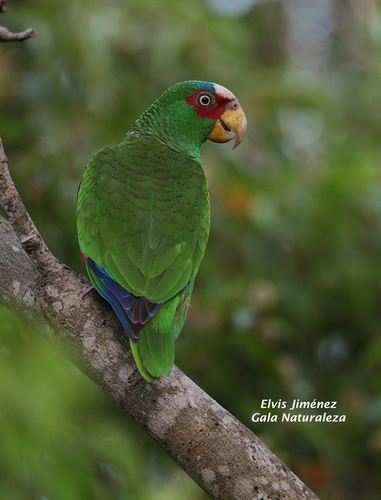
White-fronted Amazon
The White-fronted Amazon (*Amazona albifrons*) is a vibrant and relatively small parrot species native to Central America and Mexico. It is known for its distinctive white patch on the forehead, which contrasts with its bright green body and red and blue accents on the wings. This parrot plays a crucial role in its ecosystem as a seed disperser, contributing to forest regeneration. While not as widely recognized in popular culture as some larger Amazon parrots, the White-fronted Amazon is valued in aviculture and holds significance for local communities within its range, sometimes featuring in folklore and traditional practices.
25-28 cm
Length
Not readily available, but proportional to body size cm
Wingspan
Least Concern
Conservation Status
Distribution
The White-fronted Amazon is found along the Pacific coast of Mexico, extending south through Guatemala, El Salvador, Honduras, Nicaragua, and into northwestern Costa Rica. There is also a separate population on the Yucatan Peninsula. They are non-migratory, though they may make local movements in response to food availability.
Lifespan
In captivity, they can live for 40-50 years, and potentially longer. Lifespan in the wild is likely shorter, but precise data is limited.
White-fronted Amazon's Habitat
Habitat Types
Dry deciduous forests, Savannas, Arid scrublands, Agricultural areas with scattered trees, Mangrove edges (Yucatan population)
Climate Zones
Tropical, Subtropical
Adaptations
Their strong beaks are adapted for cracking nuts and seeds, a common food source in their drier habitats. Their zygodactyl feet (two toes forward, two toes backward) provide excellent grip for climbing and manipulating food.
Variations
Three subspecies are generally recognized: *A. a. albifrons* (nominate subspecies), *A. a. saltuensis* (found in northwestern Mexico, and has a bluer crown), and *A. a. nana* (smaller, found in the Yucatan Peninsula).
Appearance
Breeding Plumage
No significant difference between breeding and non-breeding plumage.
Seasonal Feather Changes
Minimal seasonal variation.
Sex Based Plumage Differences
Males have red feathers on the bend of the wing, while females have green. The extent of the white forehead patch can also vary, often being larger in males.
Notable Features
White forehead patch, Red around the eyes (spectacles), Blue on the crown and flight feathers, Yellowish-green body plumage
Diet and Feeding
Primary Foods
Seeds, Fruits, Nuts, Flowers, Leaf buds
Foraging Behavior
White-fronted Amazons forage in flocks, often in the morning and late afternoon. They are primarily arboreal, feeding in trees and shrubs. They use their beaks and feet to manipulate food items.
Specializations
Their strong beak allows them to crack hard-shelled seeds and nuts that other birds may not be able to access.
Seasonal Diet Variations
Their diet varies depending on the availability of fruits and seeds throughout the year. During the dry season, they may rely more on seeds and nuts, while during the wet season, they may consume more fruits.
Behavior
Social Structure
White-fronted Amazons are highly social birds, usually found in pairs or flocks. Flock size can vary from small groups to larger gatherings, especially outside of the breeding season.
Communication
Loud, raucous calls, Screeches, Whistles, Visual displays (head bobbing, feather ruffling)
Migration
Non-migratory, but may undertake local movements in response to food availability.
Territorial or Group Behaviors
During the breeding season, pairs become territorial and defend their nesting site. Outside of breeding, they are generally gregarious and form communal roosts.
Conservation
Threats
Habitat loss (deforestation for agriculture and development), Illegal pet trade (capture of wild birds), Human persecution (sometimes considered agricultural pests)
Protection Programs
CITES Appendix II (regulates international trade), Protected areas within their range (national parks, reserves)
Local National Laws
Protected under national laws in several countries within their range, prohibiting capture and trade.
Population Trend
Decreasing
Population Estimates
While listed as Least Concern, the global population is believed to be declining, though specific numbers are difficult to obtain due to their wide range and often-inaccessible habitats.
Interesting Facts
They are one of the most sexually dimorphic Amazon parrot species.
The clear difference in wing feather coloration between males and females makes them easily distinguishable.
They are known for their playful and curious nature.
This makes them popular in aviculture, but also contributes to their vulnerability to trapping.
The subspecies *Amazona albifrons nana* is the smallest of all Amazon parrots.
This highlights the regional variations within the species.
Faqs about White-fronted Amazon
Can White-fronted Amazons talk?
Yes, like many parrots, they can mimic human speech and other sounds. Their talking ability varies between individuals.
Are White-fronted Amazons good pets?
They can be challenging pets due to their intelligence, social needs, and loud vocalizations. They require a significant commitment of time and resources. *Consult with an avian veterinarian or experienced parrot owner for expert advice.*
What is the biggest threat to White-fronted Amazons?
Habitat loss due to deforestation is considered the most significant threat to their long-term survival.
Are White-fronted Amazons endangered?
No, White-fronted amazons are catagorized as Least Concern by the IUCN.
Copyright @ Nature Style Limited. All Rights Reserved.
 English
English